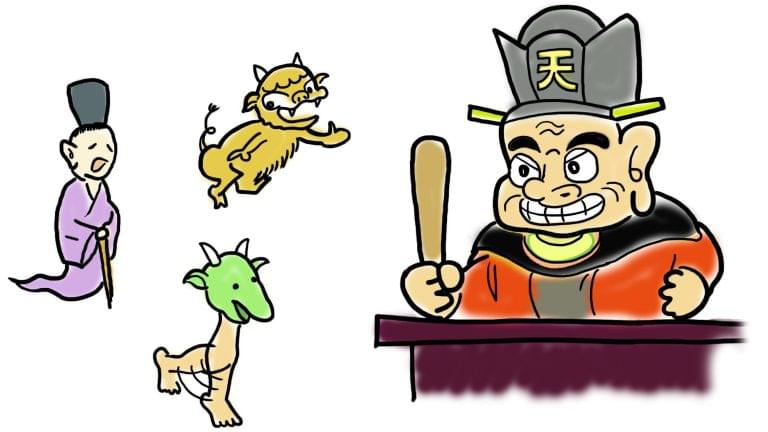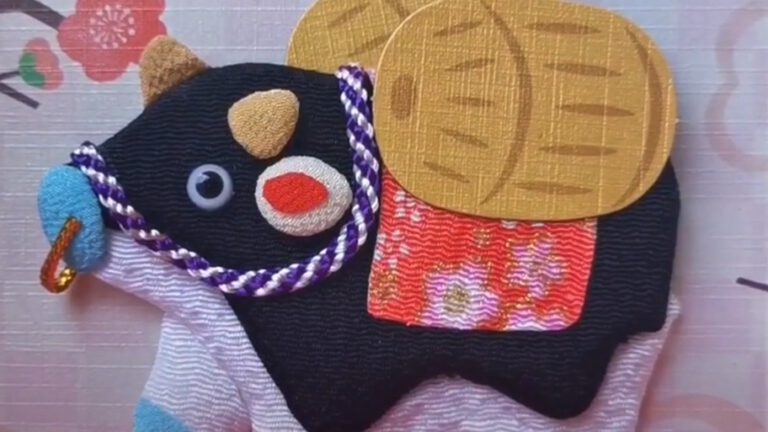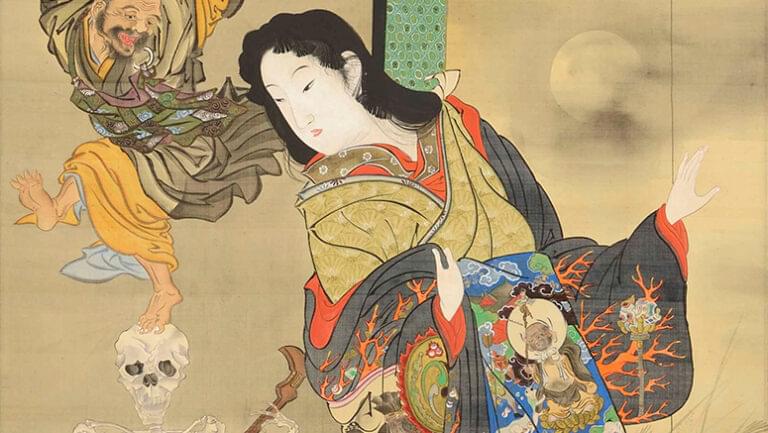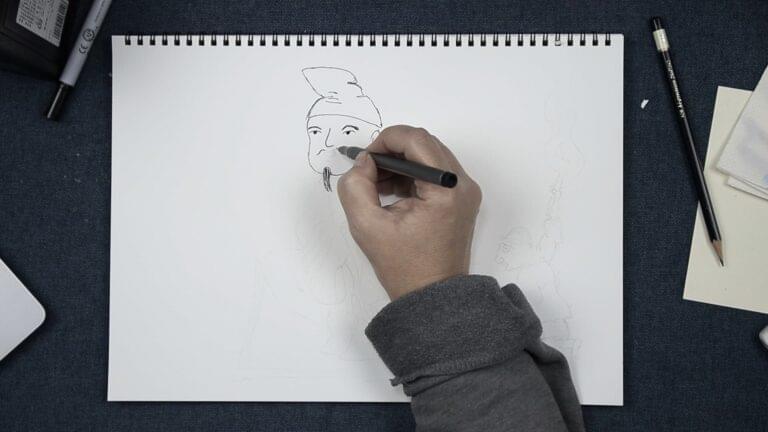This is Thersa Matsuura and you’re listening to Uncanny Japan.
Want to hear a cute word? Ready? Shochikubai. It’s fun to say. It’s the characters for: pine, bamboo, and plum. And it’s one of those darling parts of Japanese culture that if you’re not paying attention you don’t even notice, but once you do discover it and learn what it means, it makes you go wow! and isn’t that clever? and also feel a little bit smarter.
Today I’ll tell you about shochikubai, some samurai throwing shade, and a couple other “end of the year”-related lucky goodies.
Intro: Shochikubai — Three Winter Friends
Hey hey, how are you? We’re almost there. Almost to 2024. How are you going to welcome in the New Year? Well, let me tell you about something you’ll see all over Japan that both invites in that Good New Year Luck, but also has another somewhat different meaning. That’s shochikubai.
Shochikubai — pine, bamboo, plum — grouped together like this has a very long history. This trio is what — since ancient times — has been called the “The three friends of Winter” or saikan no sanyū / 歳寒の三友 in Japanese. Now by “ancient times” I mean the idea began in China and was brought to Japan during the Heian Era. It adapted here and is still around and used today, especially during the oshogatsu or New Year holidays.
But before I get into other places you’ll most likely run into this threesome, why are they dubbed winter friends? Well, all three have the ability to withstand harsh conditions — like winter — with strength, dignity and beauty. Let’s look at each one real quick.
Pine, Bamboo, Plus: What do They Mean?
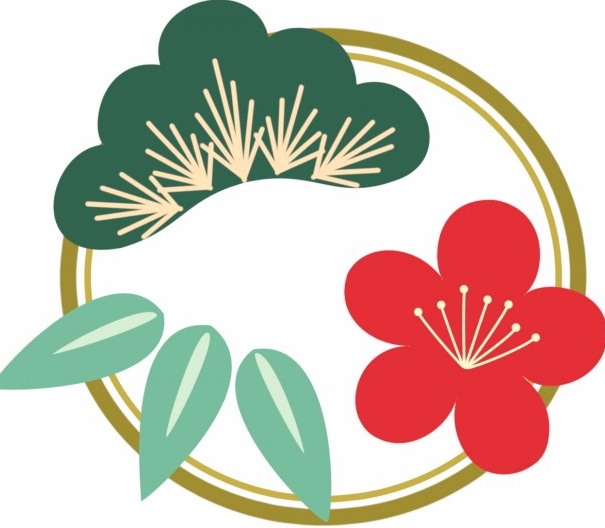
The matsu or pine tree is not just a symbol of strength but also long life. The fact that they remain green all year shows endurance and vitality, too. You’ll find them in Zen art and gardens. Another plant Buddhism is fond of is the bamboo or take. Bamboo also stays green through winter despite the cold. But it has the added bonus of being tough, hard to break, but very flexible at the same time. And let’s not forget it grows quickly. So add growth to durability to its positive traits.
Finally, we have the ume or plum. The plum tree’s blossoms are just gorgeous and the smell lovely, too. It’s said that even when a plum tree is old enough to be covered in moss, it will — at the tail end of winter — with snow still on its branches, bloom. So they, of course, represent strength and beauty but also hope.
If you think about it, shochikubai is a metaphor for having a great character and overcoming adversity. All these qualities are admirable and something we as human-people, can look at and learn from or aspire to: strength and grace when things are difficult. Flexibility, adaptability and resilience are good to have on hand. And hope is extremely powerful. It gives meaning to life, helps us persevere, and keeps a positive mindset. If you can do all that, look good and smell nice, too, then you are doing very well, my friend.
Because of all the above, together the pine tree, bamboo and plum tree are symbols of auspiciousness. Once you start looking, you’ll see them everywhere: in paintings, woodblock prints, lacquerware, ceramics, flower arrangements, and labels; especially around the New Year season.
Kadomatsu
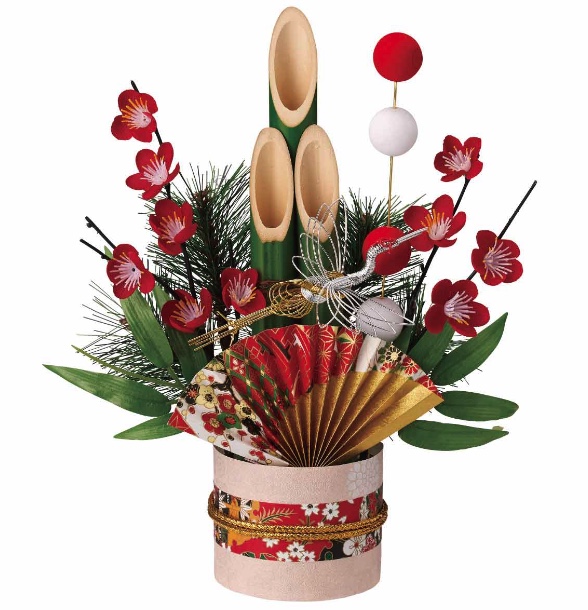
There is something you might have seen or be familiar with called a kadomatsu. These are New Year decorations displayed on either side of a gate, a door or some kind of entrance to of businesses, shrine or even your home. They can be quite huge — as tall as you, or very small — something you can pick up at Daiso for 100 yen.
Again brought to Japan from China around the 8th century, the original ones didn’t look quite like the ones you’ll find today. There are still variations but a couple things are always present.
First, bamboo. A kadomatsu has three or five pieces of bamboo of differing lengths, standing upright or with older designs, at angles. Speaking of angles, the tops are cut at an angle (called sogi). However, they used to be cut straight across (called zundō). The reason for the change is really interesting.
Angry Samurai
The story goes that in the late Warring States Period (Sengoku Jidai), the daimyo Takeda Shingen actually defeated Tokugawa Ieyasu and Oda Nobunaga in the Battle of Mikatagahara. Now, Ieyasu had been undefeated until this time and he was livid. This happened December 22nd, 1572, when people were starting to get ready to prepare for the New Year, right?
In his anger and frustration, Ieyasu took his sword and sliced straight through a nearby bamboo stalk. He told his retainers from now on all kadomatsu are to be cut in this manner. Not straight across as they had been.
What makes this story is absolutely brilliant is this — follow me for a second.
1) Bamboo is called take. The great feudal lord who defeated Ieyasu was named Takeda, or bamboo field. And 2) the type of cut Ieyasu used — that diagonal one — is called kesagiri. Giri or kiri is to cut and “kesa” is a monk’s robe. You know how the robe overlaps in front, well the downward slashing motion of the sword follows that angle. When a samurai is sword fighting, kesagiri is one of the most important techniques when taking down your opponent. It’s both fast and very incapacitating.
So Ieyasu was symbolically cutting down Takeda Shingen. Since he couldn’t do it in real life, he did manage change the way kadomatsu were made from then on out. Thumbing his nose at Takeda.
However, as clever as that is, Tokugawa Ieyasu still didn’t have the last word. After the battle, Takeda Shingen wrote and sent him a poem that said:
まつかれて たけたくひなき あしたかな」
Keep in mind, Ieyasu’s clan was called Matsu Daira or the Pine clan. So Takeda’s cheeky poem translates something like: “The pine withers and declines, the bamboo shall prosper like no other!” Sickburn.
It was said that Ieyasu was so depressed after reading this poem he was inconsolable, wouldn’t leave his futon. BUT! one of his loyal retainers was super clever and RE-imagined the poem, reading it the same way but by changing the kanji he was able to make it say: “I wonder if Takeda will be headless tomorrow due to pine blight”. Just incredible.
As to who had the last word though. Ieyasu was never defeated again and died peacefully in his sleep at the age of 73, while sadly Takeda died quite young at around 49 of a mysterious illness. So maybe Ieyasu DID get the last word.
Toshigami-sama: The God of the New Year
Okay, back to kadomatsu. You have your bamboo and it’s surrounded by pine branches. The Matsu in kadomatsu. So that’s two of the shochikubai. There are other decorations as well and one you’ll find is plum flowers. Trifecta.
By placing a pair of kadomatsu outside your home you invite the Shinto god, Toshigami-sama into your house. Toshigami-sama if beckoned nicely will enter and bring you happiness and good fortune for the new year.
When Not to Decorate
A couple things to keep in mind, though, if you’re planning to decorate with your own kadomatsu, don’t put them out on December 29th or 31st. The 29th, 2 and 9 are pronounced ni ku which sounds like nikurashii and that, my friends, means hateful, loathsome, or detestable. Not lucky at all. So don’t put out any of your New Year’s decorations on the 29th.
The 31st isn’t good either because it shows the Toshigami-sama that you rushed with your preparations and only just put them out the day before the New Year. It’s called ichiya kazari. One night decoration. Don’t be rude.
Also remember that the Toshigami-sama will remain in your house until January 7th, so don’t take those kadomatsu down until after it leaves. Make this lucky god feel welcome.
Another Use for Shochikubai
So that’s all about the New Year, but shochikubai is used all year in a different way. The first time I ever realized pine, bamboo, and plum were used somewhere other than holiday new year’s cards was once when I was ordering sushi from a menu. There were three different plates and I had to choose whether I wanted the one called pine, bamboo, or plum.
It’s close to a direct quote, but I said something like: Pine sushi, eyu! To which my mother-in-law smiled and explained what I was looking at. That’s when I learned when you want to divide something into different grades or levels instead of saying something like top-tier, middle-tier, bottom-tier, or — I don’t know — exclusive, prime, basic, you use shochikubai.
Traditionally there is no ranking of the three lucky plants. All are equal winter friends, but when used this way plum represents regular or ordinary while bamboo is one level up from that, middle. And then if you want to really splurge and get the top rank, you order matsu or pine.
I read that this started originally at sushi and eel restaurants back in the day so that people didn’t sound pretentious when ordering the highest quality meal. Or feel the embarrassment of ordering the lowest level meal. Because “ume” or plum is so much nicer than “nami” regular or average.
Shochikubai not only ranks quality but also price. Today I learned there’s something called the Law of Shochikubai, which basically means when given a choice between three grades, pine, bamboo, and plum, most people will choose bamboo, the middle one. I think this is called the Center Stage Effect or Decoy Effect in English.
Red Light District Ratings
Okay to end on a perfectly weird note: Another bit of trivia is that shochikubai used as a ranking system even extended to the red light district or yūkaku back in the Edo Era. Although here, the order was a bit different. The tayu, highest ranked courtesan was called a matsu or pine; the mid level was a plum or ume; while the bottom wrung was bamboo, take. So, there you go.
Okay, thank you bunches for listening. Thank you patrons for you wonderful support. Everyone stay safe and well and I’ll talk to you in two weeks, the last show of the year.
Bye bye!

